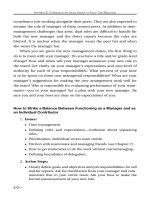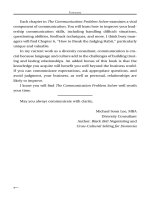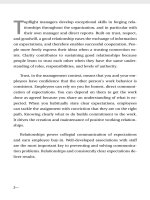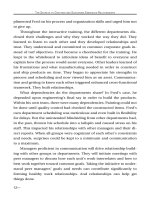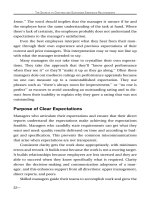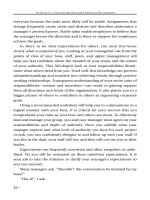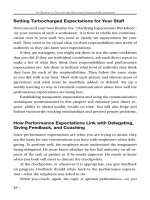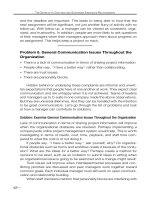The Communication Problem Solver 20 pps
Bạn đang xem bản rút gọn của tài liệu. Xem và tải ngay bản đầy đủ của tài liệu tại đây (79.49 KB, 10 trang )
Skilled managers develop partnerships with their direct reports.
Partnerships lead to collaborative conversations.
Building and Maintaining Trust and Credibility
Collaborative conversations require trust. The manager needs to in-
spire trust before expecting to get it back. Sometime in your career
you have probably heard someone say, ‘‘Trust me.’’ What was your
reaction? Words do not inspire trust. Management behaviors do.
Being consistent and doing what you say you will do are trust-
building behaviors.
Most of us look for patterns of behaviors before we trust some-
one, and that trust grows deeper as we see consistent actions. When
people align their words with their actions, they signal trustworthi-
ness. Being honest and able to admit mistakes conveys open com-
munication, which makes most employees more comfortable at
work. Employees also look for indications that the manager is ap-
proachable, encourages and accepts their feedback, and stands up
for them. Caring for the employees’ best interests, fostering mutual
success, and getting to know employees grows trust.
The manager’s competence and clear-cut goals trigger credibil-
ity. The ability to provide meaningful information, to follow
through, and to hold people accountable generates credibility. The
actual act of delegating extends trust to the employee and leads to
faith in the manager’s ability to assess the work and skills required
to get it done. Removing obstacles to make the direct report’s job
easier demonstrates a willingness to work on a two-way street. Shar-
ing experiences, showing commitment to the work and interest in
172—
employees, and adhering to high professional standards produce
credibility.
Sometimes employees describe a manager who is credible as
one who is willing to ‘‘roll up his sleeves and get dirty’’ to help em-
ployees in a crunch. When he does himself what he is asking em-
ployees to do, the manager engenders loyalty and collegiality. ‘‘We
did it together’’ grows teamwork.
Involving others in decision making and asking for feedback and
opinions demonstrates commitment to a ‘‘we’’ approach. This be-
havior corresponds with a manager’s intention to work jointly. Be-
havior is what counts, not words or intentions. When a manager is
always dependable, credibility and trust are built, and in turn grease
the wheels of collaborative conversations and relationships.
—173
This page intentionally left blank
CHAPTER
8
Giving Feedback—
SweetorSour?
This chapter tackles the definition, types, and benefits of feedback. It
calls attention to the importance of starting with the performance expec-
tation and then stating the observed performance and its impact on the
goal and/or team. It includes a real-world example of how to tie feed-
back to performance expectations.
Two types of feedback—positive reinforcement feedback and redi-
rective feedback—are covered. Managers need to have a process for both
types of feedback—one for supporting the current behavior of the em-
ployee and a separate process for redirecting the behavior. For redirec-
tive feedback, managers can plan what they will say before they discuss
the situation with their direct report to feel more comfortable. This plan-
ning gives them fuller preparation and more confidence in the feedback
conversation. Managers can assure themselves that there is no need for
sweaty palms because they are prepared with facts and an intention to
help the employee.
This chapter also addresses the value of managers inviting feedback
from their direct reports and how that impacts business results.
What Is Feedback?
Feedback is telli ng people on a re gula r basis how they are doing in
relation to the expecta tion s and goals. This vit al commun icat ion is
—175
L
EADING
C
OLLABORATIVE
C
ONVERSATIONS
honest and friendly and given with the intention of helping employees
meet their ob ject ives. It is an opportunity to keep th e com muni catio n
channels open. If deliv ered well , feedback contribu tes to relationship
building. Pe ople want t o kno w how they are doing in rel atio n to t he
job at hand. They w ant to be affirmed when they are pr ogre ssin g. They
want supportive help to redirect when they are off course, so they can
achieve.
Feedback should be given immediately when behavior is observed,
in person or at least voice-to-voice. When it is given on a regular basis,
the employee can feel confident that he or she is on the right track. This
reduces stress and uncertainty. When given frequently, feedback be-
comes part of collaborative, ongoing conversations rather than a big
deal. It is a habit and therefore expected and nonthreatening.
When a manager chooses positive words, friendly (and nonjudg-
mental) tone of voice, and appropriate timing, feedback keeps people
alert to what is important to the organization and how well they are
fulfilling the expectations. This communication creates a comfortable,
trustworthy environment because employees can trust that their per-
formance will be observed and commented on with the intention of
keeping them informed, developing their skills, and ensuring their opti-
mum contribution to the team.
Chapter 2 (‘‘Setting Expectations with Turbocharged Clarity’’) em-
phasized that feedback goes hand-in-hand with stating clear expecta-
tions. Expectations and feedback work in tandem. You cannot separate
them, because feedback is geared toward communicating the extent to
which expectations are met. Every time a manager gives feedback, he
reinforces the importance of the expectation. When a manager does not
give feedback, employees must guess if what they are doing is achieving
the goals and meeting managerial expectations. Employees may operate
out of fear of failure or may assume they are on the right course if the
manager does not clarify expectations and does not deliver feedback.
Trust, the relationship, and the work often suffer, as in the following
example.
176—
G
IVING
F
EEDBACK
—S
WEET OR
S
OUR
?
Unrealistic Expectations and Lack of Helpful Feedback
One Sunday I was riding the Hampton Jitney bus from Montauk, Long
Island, to La Guardia Airport. When my seatmate learned I was writing
this book, she told me a story about her daughter, Antoinette, who
worked at an art gallery in Chelsea that had about ten employees. Antoi-
nette was hired to sell art. When one of her coworkers, the bookkeeper,
left on maternity leave, Antoinette’s manager asked her to do the book-
keeping as well. Antoinette asked for more money to add those job du-
ties. The manager said, ‘‘No. It will be good experience and will look
good on your re
´
sume
´
.’’
According to Antoinette’s mom, ‘‘The boss is cold and never compli-
ments my daughter, who is doing two jobs. Antoinette has had no train-
ing in bookkeeping and sometimes makes mistakes. The boss reacts
negatively instead of understanding that of course she will make mis-
takes—she is not a bookkeeper. The boss never thanks anyone. People
who work there are afraid to admit errors. No one wants to take respon-
sibility for anything that goes wrong.’’
Then she asked me if I thought all women managers think they have
to act cold and curt and not be friendly to be effective as a boss. She
had extrapolated from one unskilled manager (who did not set realistic
expectations and who gave unhelpful, perhaps damaging, feedback) to
all women managers. Just then, a man across the aisle handed me the
New York magazine he had been reading. The blue cover sported titles
like, ‘‘Do You Have to Be a Jerk to Succeed?’’ Apparently having an un-
knowledgeable, ineffective boss is a common theme. The issue seemed
to be dedicated to articles about workplace problems.
Like Antoinette’s boss, many untrained managers are unaware of the
basics of building relationships, setting realistic expectations, providing
resources including training, and giving job-related constructive feed-
back. Many managers have a difficult job handling these important com-
munication activities, yet communication is the cornerstone for getting
things done with and through others.
Why is workplace miscommunication such an area of interest for
—177
L
EADING
C
OLLABORATIVE
C
ONVERSATIONS
articles, research, surveys, television shows like The Office, and cartoons
like Dilbert? There’s a reason The Office is so well liked. The characters
demonstrate relationship and communication problems that are played
out every day in the workplace. Viewers laugh because the communica-
tion misfires are so familiar. At least the boss is likable and has all the
best intentions for his staff. Still, his management skills are lackluster
and affect results.
Example: Tying Expectations to Frequent Feedback
Fortunately, many managers are skilled at setting reasonable expecta-
tions and following up with friendly, job-related feedback that is con-
structive to the employees’ success, to the relationships, and to the
success of the business. An excellent model of a company that ties to-
gether expectations with feedback is the example we used in Chapter 2
on clarity of expectations: the Balboa Bay Club & Resort (BBC&R) of
Newport Beach, California. The same example is used again here to com-
plete the model of how to tie together setting expectations with giving
feedback in a productive manner.
BBC&R provides an exemplary experience to their guests by both
setting high expectations for all employees and making continual feed-
back about those expectations part of the daily work. Managers give
feedback to employees. The quality manager, Cynthia Goins, gives feed-
back to managers and employees. Employees also give feedback to man-
agers and Cynthia. The open-door policy flourishes because all are
aware that they are striving for the same ultimate goals and everyone
wants all employees to be happy. The leaders have built trust and rela-
tionships so all staff expect feedback on an ongoing basis.
Cynthia Goins works in Human Resources (HR), so most of the em-
ployees she gives feedback to are not her direct reports. However, she
has the support of executives to go to housekeeping, the kitchen, and
other departments to meet with department heads. She tells them, ‘‘I
heard . . .’’ or ‘‘I saw . . .,’’ and addresses what she heard or saw with the
178—
G
IVING
F
EEDBACK
—S
WEET OR
S
OUR
?
manager. This might be feedback from guests or employees. Cynthia
says, ‘‘We treat employees as we would treat guests and members. We
take time, listen to employees, and make them a priority. Once employ-
ees see it in a leader, they’ll do it with guests.’’
Cynthia phones the hotel periodically to see how employees answer
the phone. She gives feedback, so there is constant communication
about the importance of how the phone is answered. Employees make
every effort to go above and beyond expectations of the industry. Cyn-
thia says, ‘‘The Balboa Bay Club & Resort is not in the business of selling
service, but in the business of selling an experience for the guest—
something unexpected. We accomplish this experience by really listen-
ing to and paying attention to guests, engaging them.’’
BBC&R has processes in place to ensure exceptional customer expe-
rience. It teaches techniques such as finding commonalities with guests,
like noticing they have the same last name. BBC&R is continually looking
for ways to enhance the experience for guests. The staff discuss, ‘‘What
are we doing about this comment card?’’ They share best practices from
other places they visit and never take for granted what they learn from
other hotels.
Rather than sit at a desk, Cynthia walks around and asks employees
about what happened yesterday. If there was a problem with package
delivery, they talk about it. Standing outside in the porte cochere, if she
sees a bellman taking guests to the front desk, she reinforces great be-
havior. While I interviewed her by phone, she asked me to wait a minute
while she wrote down something she had just heard a room reservations
agent say to a guest. As soon as we got off the phone, Cynthia intended
to mention to the employee what he had said and why it was effective
and important and to urge him to keep that up. ‘‘If we expect guests
to be acknowledged, we have to do the same thing as managers and
acknowledge both guests and employees,’’ she said.
BBC&R encourages managers to write simple thank-you cards to em-
ployees when the manager observes outstanding behavior. Managers
recognize that person in writing and give the card in public in front of
—179
L
EADING
C
OLLABORATIVE
C
ONVERSATIONS
peers. They also publicize it on the Daily Lineup Sheet because every
employee sees that. Reinforcing good behavior is a regular part of feed-
back at the Balboa Bay Club & Resort. In addition to informal recogni-
tion, BBC&R also has formal recognition programs, such as employee of
the quarter and of the year. The winners get a crystal award, a check,
and their picture posted outside the galley—the employee dining area.
When managers give feedback, it is always about the standards. For
example, if Cynthia forgets to wear her name tag, she expects other em-
ployees to give her immediate feedback so she can correct it:
I would be disappointed if they didn’t tell me, because we are sup-
posed to be looking out for each other. We have open communication
because we all understand what we are striving for and why we are
doing it. We are not afraid to tell each other, ‘‘You’re slouching’’ or
‘‘You’ve got a five o’clock shadow and you said you wouldn’t come
with one again.’’ They’re not offended, because of trust. Employees
at BBC&R enjoy what they are doing and we enjoy working with our
coworkers. It’s all part of relationship and trust.
Two Types of Feedback
There are two important types of feedback: positive reinforcement and
redirective. Both have a purpose and an appropriate use, depending
upon whether or not the expectations are being met. Both are important
communication tools.
Positive reinforcement feedback recognizes and reinforces specific
desired behaviors. This feedback specifies positive behaviors that the
manager wants to see repeated. Positive reinforcement feedback com-
municates that expectations are being met or exceeded and lets the em-
ployee know exactly what to keep doing.
Redirective feedback asks the employee to change, or redirect, her
behavior to better align herself to meet goals and expectations. This
feedback is sometimes called corrective because it helps the employee
adjust her approach early on so she can meet expectations and be suc-
180—
G
IVING
F
EEDBACK
—S
WEET OR
S
OUR
?
cessful. This type of feedback assists the direct report in knowing exactly
what to do differently so she can change her actions.
It is important to give both types of feedback on a regular basis so
employees can count on knowing their performance status. When em-
ployees expect both types of feedback, they understand feedback in the
greater context of helping them achieve the goals and expectations. This
enables them to view both positive reinforcement and redirective feed-
back as collaborative conversations.
Guidelines for Both Types of Feedback
When delivering either type of feedback, there are some guidelines.
These general tips contribute to making the conversations collaborative
and most effective.
Feedback is an important communication tool, so give it in person
or at least voice-to-voice (not by e-mail). E-mail is frequently misunder-
stood and can be blown out of proportion. Always link the feedback
directly and explicitly to the expectation or goal and tell why that expec-
tation is important. (Yes, even if you have said it many times before.)
Be sure to discuss only one specific situation at a time—not ‘‘you
always, you never, you often, or you usually,’’ even with positive rein-
forcement. It is also important to identify precise, observable behavior
rather than making opinion or judging comments. A manager can also
gather facts from project management milestones, plans, goals, required
processes, procedures, and other stated expectations. Facts clarify the
communication and allow both the manager and the direct report to
remain objective and results oriented. Judgments or opinions can lead
to conversational detours so the main point gets lost.
Be sure to give enough unambiguous and factual information to en-
able the employee to repeat the performance or make a requested
change. While it’s nice to hear, ‘‘Good job,’’ it is insufficient information
for a person to know exactly what that means. Similarly, comments such
—181

